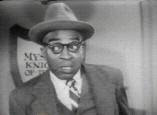Blacks in Blackface
Famous Black actors whose personas were derived from racist blackface stereotypes
The American minstrel show was effectively dead by WW1, yet some old-timers continued to peddle the same blackface stereotypes later in vaudeville, films and television. It's one of the interesting twists of history that in the first half of the twentieth century, the main purveyors of the old-fashioned blackface minstrel tradition were Black performers, who'd began in show business wearing the blackface mask -- either literally or figuratively -- and were reluctant to give it up.
But they also had little choice in the roles they were offered. Until well into the 1950s, Black male actors were limited to stereotypical roles: Coons, for example, Stepin Fetchit, Mantan Moreland, and Willie Best; and Toms, the most famous were Bill "Bojangles" Robinson and Eddie "Rochester" Anderson. Likewise, the only film roles for Black women were maids and mammys, and the most famous mammy of all was Hattie McDaniel, best known for her Oscar-winning role as "Mammy" in Gone With the Wind.
|
Eddie Anderson 1902-1977 "Rochester" The son of a minstrel singer and circus tightrope walker, Eddie Anderson started out in vaudeville and had appeared in a number of films when he debuted as the voice of a Pullman porter on Jack Benny's popular radio show in 1937. |
|
|
Louise Beavers appeared in over 160 films from the 1920s through the 1950s, most often as a mammy stereotype in the role of a maid, servant, or slave. Beavers' most famous role was her portrayal of Delilah Johnson, the housekeeper whose employer transforms her into an Aunt Jemima character for an advertising campaign in the 1934 film Imitation of Life. |
|
|
Willie Best 1913-1962 "Sleep 'n' Eat" Best was never given the opportunity to fully flex his comedic muscle beyond the stereotyped porter and janitor roles that dominated his career. |
|
|
Ruby Dandridge is best known for playing maids on radio, movies and television. All Ruby had to do was open her mouth and let that squeaky voice come forth, and audiences would break into hysterics. |
|
|
Stepin Fetchit became a very wealthy man portraying "the laziest human being in the world" |
|
|
Clinton "Dusty" Fletcher got his start in Hollywood in Rufus Jones for President (1933), but it was his role in Open the Door Richard (1945) that served as a showcase for his comedic talents. |
|
|
Allen Clayton Hoskins 1920-1980 "Farina" Allen Hoskins was the character of Farina in the Our Gang short films from 1922 to 1931. Farina was cast to be the stereotypical pickaninny in the tradition of the character Topsy from Uncle Tom's Cabin. |
|
|
Billy Kersands 1842-1915
Billy Kersands was the most famous negro blackface minstrel and vaudeville performer of the 19th century, who entertained audiences with comedy, dancing, singing, music and acrobatics. He was best known and remembered for the size of his mouth, which he could fill with billiard balls while reciting a monologue. |
|
|
John D. Lee Jr. 1898-1965 "Johnny Lee" Johnny Lee played the shyster lawyer Algonquin J. Calhoun in the Amos 'N' Andy TV Series. |
|
|
Dewey Pigmeat Markham 1904-1981 Best known for his signature routine "Here Come Da Judge." Although he performed exclusively for Black audiences until very late in his career, he refused to abandon blackface until the 1950s. It was as integral to his performance as any costume. |
|
|
Hattie McDaniel is best known for her portrayal as "Mammy" in 1939's Gone with the Wind. She was the first African-American to win an Academy Award. |
|
|
Thelma "Butterfly" McQueen (1911-1995) Butterfly McQueen is most famous for her role in Gone With the Wind (1939) as the slave " Prissy" with the high squeaky voice who didn't "know nothin' 'bout birthin' babies." |
|
|
Tim Moore 1887-1958 "George "Kingfish" Stevens" Although Tim Moore will forever be known as "The Kingfish" in the pioneering series The Amos 'N' Andy Show, he was actually far better known for his career on the stage and as a comedian in vaudeville. |
|
|
Moreland's defining role was that of Birmingham Brown, the loyal chauffeur to master detective Charlie Chan in fifteen films made by Monogram Studios in the 1940s. |
|
|
Bill "Bojangles" Robinson 1878-1949 He was called "the quintessential Tom" because of his cheerful and shameless subservience to whites in films. But in real life Robinson was the sort of man who, when refused service at an all-white luncheonette, would lay his pearl-handled revolver on the counter and demand to be served. |
|
|
Nick Stewart 1910-2000 "Lightnin" Character actor from vaudeville and radio who is best known as Lightnin' from the Amos 'N' Andy Show. He was one of the first inductees in the Academy of Television Arts and Science's new Archive of American Television. |
|
|
Billie Thomas 1931-1980 "Buckwheat" Billie Thomas (originally William Thomas, Jr.) is best remembered as Buckwheat in the Our Gang (Little Rascals) shorts from 1934 until the series ended in 1943. |
|
|
W.C. Fields called him "the funniest man I ever saw and the saddest man I ever knew." Unable to realize his highest ambitions, yet able to illuminate a degrading caricature with rare humanity, Bert Williams earned a place as one of the most significant figures in the history of American show business. |
|
|
Spencer Williams, Jr. 1893-1969 "Andy Brown" Spencer Williams, Jr. who would become known to TV audiences as Andy Brown in The Amos 'N' Andy Show produced, directed, and acted in numerous race movies through the 1930s and 1940s. |
|
Please visit our partners:
Buy * Will Write for Food * T-shirts
Kachina.us - Guide to Hopi Kachina Dolls
Agile Writer -- Biography and History























Comments
Post a Comment